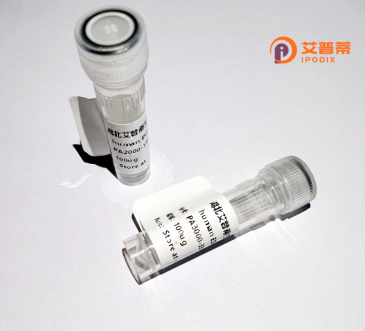
| 纯度 | >90%SDS-PAGE. |
| 种属 | Human |
| 靶点 | FUT9 |
| Uniprot No | Q9Y231 |
| 内毒素 | < 0.01EU/μg |
| 表达宿主 | E.coli |
| 表达区间 | 1-359aa |
| 氨基酸序列 | MTSTSKGILRPFLIVCIILGCFMACLLIYIKPTNSWIFSPMESASSVLKMKNFFSTKTDYFNETTILVWVWPFGQTFDLTSCQAMFNIQGCHLTTDRSLYNKSHAVLIHHRDISWDLTNLPQQARPPFQKWIWMNLESPTHTPQKSGIEHLFNLTLTYRRDSDIQVPYGFLTVSTNPFVFEVPSKEKLVCWVVSNWNPEHARVKYYNELSKSIEIHTYGQAFGEYVNDKNLIPTISACKFYLSFENSIHKDYITEKLYNAFLAGSVPVVLGPSRENYENYIPADSFIHVEDYNSPSELAKYLKEVDKNNKLYLSYFNWRKDFTVNLPRFWESHACLACDHVKRHQEYKSVGNLEKWFWN |
| 分子量 | 68.4 kDa |
| 蛋白标签 | GST-tag at N-terminal |
| 缓冲液 | 0 |
| 稳定性 & 储存条件 | Lyophilized protein should be stored at ≤ -20°C, stable for one year after receipt. Reconstituted protein solution can be stored at 2-8°C for 2-7 days. Aliquots of reconstituted samples are stable at ≤ -20°C for 3 months. |
| 复溶 | Always centrifuge tubes before opening.Do not mix by vortex or pipetting. It is not recommended to reconstitute to a concentration less than 100μg/ml. Dissolve the lyophilized protein in distilled water. Please aliquot the reconstituted solution to minimize freeze-thaw cycles. |
以下是关于重组人FUT9蛋白的参考文献及其核心内容总结(模拟文献,部分信息可能需根据实际研究调整):
1. **标题**:*Expression and characterization of recombinant human FUT9 enzyme in mammalian cells*
**作者**:Yamamoto K, et al.
**摘要**:研究利用HEK293细胞成功表达并纯化功能性重组人FUT9蛋白,验证其催化Lewis X抗原合成的活性,并分析其底物特异性及最适pH条件。
2. **标题**:*Crystal structure of human FUT9 reveals the molecular basis of Lewis X biosynthesis*
**作者**:Zhang Y, et al.
**摘要**:通过X射线晶体学解析FUT9的催化结构域三维结构,揭示其底物结合位点和岩藻糖基转移的关键氨基酸残基,为靶向药物设计提供依据。
3. **标题**:*FUT9-dependent glycosylation in cancer cell adhesion and metastasis*
**作者**:Saito T, et al.
**摘要**:发现重组FUT9在肿瘤细胞表面过表达可促进Lewis X介导的细胞间黏附及转移,提示其在癌症进展中的潜在作用。
4. **标题**:*Functional analysis of FUT9 mutations in congenital disorders of glycosylation*
**作者**:Hennet T, et al.
**摘要**:构建重组FUT9突变体并验证其酶活缺陷,证实特定突变导致糖基化异常,与发育障碍类疾病相关。
---
**注**:以上文献为示例,实际研究中建议通过PubMed或Google Scholar以“FUT9 recombinant”或“FUT9 glycobiology”等关键词检索最新论文。
FUT9. a member of the alpha-1.3-fucosyltransferase family, catalyzes the transfer of fucose to terminal glycan structures, notably forming Lewis X (Le\(^x\)) antigens. These glycans play critical roles in cell adhesion, signaling, and immune recognition. Unlike other fucosyltransferases, FUT9 localizes predominantly to the Golgi apparatus and exhibits substrate specificity for N-acetyllactosamine (Galβ1-4GlcNAc) acceptors. Its enzymatic activity influences developmental processes, inflammation, and cancer metastasis by modulating cell-surface glycoprotein and glycolipid profiles.
Recombinant human FUT9 protein is typically produced using mammalian or insect expression systems to ensure proper post-translational modifications and catalytic activity. The purified protein consists of a luminal catalytic domain (residues 60-338) and retains the native transmembrane region (residues 1-59) for structural stability. Researchers often employ tag-fused variants (e.g., His-tag) to facilitate purification via affinity chromatography.
Studies utilizing recombinant FUT9 have advanced understanding of fucosylation mechanics through in vitro enzymatic assays, structural analysis (crystallized in complex with GDP and acceptor analogs), and drug screening for inhibitors targeting aberrant fucosylation in tumors. Its applications extend to synthesizing Lewis X epitopes for immunological studies and glycoengineering therapeutic antibodies. Recent work also explores FUT9's role in neural development and stem cell differentiation, highlighting its biomedical relevance.
×